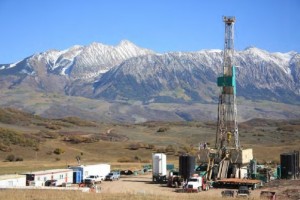A powerful congressman who had been in office 20 years once asked me, “Do you mean to say you can own the land, but someone else can own the minerals under it, and they can access it whether you like it or not?!” Believe it or not, severed mineral rights are even harder for some seasoned veterans of eastern politics to understand than western water law. A system whereby surface lands have different owners than underlying minerals, though second nature in oil-producing states, are unheard of in some parts of the country.
A classic case is playing out a few miles from my home town, just north of Paonia, Colorado. The controversy involves a Bureau of Land Management (BLM) plan to lease minerals in the “Bull Mountain Unit.” The project area is just under 20,000 acres, on which the BLM proposal would permit 146 natural gas wells. But unlike most current debates over BLM oil and gas leasing, the government doesn’t actually own 98 percent of the land involved. It’s private land, but the BLM owns minerals right under two-thirds of it. That means leasing those minerals requires an Environmental Impact Statement, which requires a very public process, and a chance for anyone to weigh in on what would otherwise be private deals between landowners and energy companies. In fact, not only do the landowners support the plan, there are surface use agreements already in place, over which BLM has no authority. Drilling on private land is regulated by the state, not the feds. But when is private land not really private?
This case has produced all the usual support and opposition: people opposed to any and all energy development, those angry about fracking, and the normal legitimate local concerns about water quality, dust, traffic, and noise. None of the arguments are much different than those raised against Keystone Pipeline or any number of other energy projects anywhere. Coloradans have seen such disagreements repeatedly. But the severed mineral ownership, on some of the land involved, makes this a different situation and a fascinating set of issues. It puts the federal government, and therefore the public, squarely in the middle of decisions involving the management of private land.We haven’t dealt much with this in Colorado, because the government also owns so much of the surface land. But it’s not as rare as you might think. Starting in 1916, the federal government privatized millions of acres of grazing lands all over the West, while opting to keep the mineral rights, so the split ownership is actually common. In Wyoming, for example, BLM owns over 11 million acres of minerals under private land.
Environmental laws require the agency to study impacts carefully before acting, and to include the public in that process. A public meeting in February at Paonia High School drew around 150 people anxious to be heard on the matter, and letters are still being accepted – the public comment period has been extended to April 16.
There is an intricate legal point here that will fascinate some, and exasperate others. BLM must study environmental impacts in all such cases, including air and water quality, endangered species and other wildlife, and more. That often includes more localized issues like noise and traffic, too, but what about this case? Clearly the agency has a duty to ensure that its action (leasing minerals) does not unreasonably impair the environment. That can be interpreted to mean only that the use of its mineral rights does not do so. That would mean analyzing effects on air quality or climate change, for instance. Others interpret it to mean that the surface uses needed to produce the minerals must be similarly scrutinized. Without question, that means BLM is studying, and taking public comment on, surface uses of private land that are otherwise regulated by the State and County, not the federal government.
Clearly, the government has the right – the duty actually – to make sure the use of its minerals is environmentally responsible. Does that also give it the power to determine how many wells are drilled on private land, how far apart they are, how often new ones are drilled, where the roads are built, or how many drill rigs are used? That is not at all clear, nor is it likely that this case alone will clarify it.
In the Hitchhiker’s Guide to the Galaxy, Douglas Adams wrote, “We demand rigidly defined areas of doubt and uncertainty!” He would have loved this issue.
(A version of this column appeared in the Grand Junction Daily Sentinel on March 27, 2015)





Comments on this entry are closed.